
April 2011
Welcome to Net Results EXPRESS
Net Results EXPRESS (NRx) is an award-winning, monthly e-newsletter highlighting medical and scientific breakthroughs, major grants and honours awarded, and other research-related events at UHN. Through NRx you can read about ongoing research at our three research institutes, the Ontario Cancer Institute (OCI), the Toronto General Research Institute (TGRI), and the Toronto Western Research Institute (TWRI). We have recently expanded our distribution list to include all employees at UHN. We hope you will find this newsletter informative and helpful. If you have feedback or questions, or have received awards or upcoming publications that you would like to be considered for coverage in NRx, please contact www@uhnresearch.ca Christopher J. Paige, PhD, FCAHS |
Lung Transplantation: High-Risk Donor Lungs Can Now Be Safely Used for Transplant
Led by Dr. Shaf Keshavjee, Director of the Toronto Lung Transplant Program and UHN's Surgeon-in-Chief, the research team found that using high-risk donor lungs which were improved and re-tested in the Toronto XVIVO Lung Perfusion System before transplantation led to results that were similar to those using conventional donor lungs. “For the first time, we can assess more precisely the function of an organ before using it. The most important finding of this study is that even donor lungs previously thought to be unusable can now be used for transplantation with excellent outcomes. This will provide more lungs with more predictable, safer outcomes after transplantation, and shorter periods of mechanical ventilation and intensive care unit stays for patients,” says Dr. Marcelo Cypel, first author of the study, and a surgical fellow in transplant and thoracic surgery who helped to develop the Toronto XVIVO System. “This heralds a new era in transplantation when we can predict how well the organ functions before using it, we can help the organ heal itself, and ultimately, we can use the Toronto XVIVO as a platform to engineer ‘super organs’ for transplantation,” says Dr. Keshavjee. Normothermic ex vivo lung perfusion in clinical lung transplantation. Cypel M, Yeung JC, Liu M, Anraku M, Chen F, Karolak W, Sato M, Laratta J, Azad S, Madonik M, Chow CW, Chaparro C, Hutcheon M, Singer LG, Slutsky AS, Yasufuku K, de Perrot M, Pierre AF, Waddell TK, Keshavjee S. N Engl J Med. 2011 Apr 14;364(15):1431-1440. [Pubmed abstract] This study was funded in part by Vitrolife. |
Respiratory Disease: Long-Term Study on the Effects of Acute Illness
The group conducted a five year study on physical function and quality of life of patients with ARDS who were discharged from intensive care units (ICU). In general, these patients had a decreased ability to exercise, a reduction in overall quality of life, and incurred a higher than normal cost to the health care system. More than half of patients suffered from a number of psychological disorders, including depression and anxiety. Furthermore, patients who had returned to work required a gradual transition back into the workforce and a modified work schedule. "This study has important public health ramifications, as these results are for relatively young, previously working persons who do not return to normal after one episode of ICU critical illness,” says Dr. Angela Cheung. “In Canada, we have a large population of aging baby boomers. This older group of patients with co-existing illness will likely have more difficulty in recovering from a critical illness.” Functional disability 5 years after acute respiratory distress syndrome. Herridge MS, Tansey CM, Matté A, Tomlinson G, Diaz-Granados N, Cooper A, Guest CB, Mazer CD, Mehta S, Stewart TE, Kudlow P, Cook D, Slutsky AS, Cheung AM; Canadian Critical Care Trials Group. N Engl J Med. 2011 Apr 7;364(14):1293-304. [Pubmed abstract] |
Lung Cancer: Changes in Non-Cancer Cells May Predict Patient Outcome
Interestingly, some of the genes identified in the CAFs from NSCLC were common to CAFs of other cancer types, such as breast and skin cancer, indicating that similar processes occur across different types of cancers. Included within this group were genes involved in promoting cell survival and adhesion, characteristics that help cancerous cells move and attach to other parts of the body. Explains Dr. Tsao, “These results provide direct evidence to support the important role of gene expression changes in CAFs, and how they affect the clinical outcome of NSCLC patients.” Prognostic gene-expression signature of carcinoma-associated fibroblasts in non-small cell lung cancer. Navab R, Strumpf D, Bandarchi B, Zhu CQ, Pintilie M, Ramnarine VR, Ibrahimov E, Radulovich N, Leung L, Barczyk M, Panchal D, To C, Yun JJ, Der S, Shepherd FA, Jurisica I, Tsao MS. Proc Natl Acad Sci U S A. 2011 Apr 7. [Pubmed abstract] This work was supported by the Canadian Cancer Society, the Princess Margaret Hospital Foundation Investment in Research Fund, the Mary Vivian Endowment Fund, the Ministry of Research and Innovation Ontario Research Fund, the Canada Foundation for Innovation, the Natural Science and Engineering Research Council of Canada and the Ontario Genomics Institute. |
Diabetes: New Guidelines for Treating Diabetic Neuropathy
Approximately half of the people with diabetes will eventually develop nerve damage, with painful symptoms usually beginning ten to twenty years after the diagnosis of diabetes. Dr. Bril conducted a comprehensive study of current medical research to help determine which treatments have the best evidence for this type of pain. She found that several treatments, including the seizure drug pregabalin and transcutaneous electric nerve stimluation, are effective and should be considered for treating diabetic neuropathy. “When diabetic neuropathy strikes, it is painful and can disrupt sleep and lead to mood changes and decreased quality of life,” explains Dr. Bril. “Evidence-based guidelines were important to develop because diabetic neuropathy is a very common problem and not properly handled by many caregivers for various reasons. ” Evidence-based guideline: Treatment of painful diabetic neuropathy: Report of the American Academy of Neurology, the American Association of Neuromuscular and Electrodiagnostic Medicine, and the American Academy of Physical Medicine and Rehabilitation. Bril V, England J, Franklin GM, Backonja M, Cohen J, Del Toro D, Feldman E, Iverson DJ, Perkins B, Russell JW, Zochodne D. Neurology. 2011 Apr 11. [Pubmed abstract] |
Neurology: Surgical Procedure Reverses Loss of Brain Matter
Under conditions where blood flow is reduced to areas of the brain as a result of diseased blood vessels, there is a progressive loss of tissue, a process known as cortical thinning. In addition to impairment of cognitive function, cortical thinning is associated with a higher risk of stroke, and the development of neurodegenerative disorders such as Huntington and Alzheimer’s disease. The group examined patients who had undergone cranial bypass surgery to restore vascularization and measured changes in cortical volume by magnetic resonance imaging. Eleven months after successful surgery, researchers observed a 5.1% increase in cortical thickness in affected areas, reversing the damaging effects of decreased blood flow. “The re-growth of brain tissue has only been observed in an extremely limited number of circumstances,“ explains Dr. Tymianski. “We consider this so important because one of the most important health issues facing our population is chronic cerebrovascular disease, which leads to neurocognitive impairment and reduced quality of life.” Surgical revascularization reverses cerebral cortical thinning in patients with severe cerebrovascular steno-occlusive disease. Fierstra J, Maclean DB, Fisher JA, Han JS, Mandell DM, Conklin J, Poublanc J, Crawley AP, Regli L, Mikulis DJ, Tymianski M. Stroke. 2011 Apr 14. [Pubmed Abstract] This work was supported by grants from the Chair Fund of the Neurovascular Therapeutics Program from the University Health Network and by the Ontario Research Fund Brain Consortium Grant. |
Autoimmune Disease: New Suppressor Gene Discovered in Lupus-Prone Mice
Earlier mapping studies—techniques that help determine the location of genes or loci—from this group have implicated sections of genes (chromosomes 1 and 4) from lupus-prone New Zealand Black (NZB) mice as contributing to the development of SLE. NZB chromosome 1 congenic mice developed fatal autoimmune-mediated kidney disease while NZB chromosome 4 congenic mice showed an increase in immune cells (B1a and NKT) in the absence of autoimmunity. In the current study, they examined whether interactions between these two loci would affect SLE autoimmunity by generating mice that carried both of these NZB chromosomal intervals. Compared to the NZB chromosome 1 congenic mice, these mice demonstrated remarkable differences including significantly reduced mortality, kidney disease and differentiation of cells producing damaging pro-inflammatory cytokines. Furthermore, a subset showed changes in levels of specific B cells and NKT activation that were correlated with even greater suppression of this disease. “These results are very exciting as they identify a suppressor locus or gene on NZB chromosome 4 that counteracts the fatal autoimmune pathogenesis mediated by NZB chromosome 1,” states Dr. Wither. “This new NZB suppressor locus could provide important insight into potentially novel methods of mediating disease inhibition in SLE.” Epistatic suppression of fatal autoimmunity in New Zealand black bicongenic mice. Loh C, Pau E, Lajoie G, Li TT, Baglaenko Y, Cheung YH, Chang NH, Wither JE. J Immunol. 2011 Apr 4. [Pubmed abstract] This work was supported by the Arthritis Society and the Canadian Institutes of Health Research. |
 |
![]()
 OCI/PMH, led by principal investigator Dr. Pamela Ohashi, has been selected as one of 27 institutions to participate in the Cancer Immunotherapy Trials Network (CITN), funded by the National Cancer Institute (NCI), to conduct Phase I and Phase II clinical trials in the area of cancer immunotherapy. OCI/PMH is the only institution outside of the United States selected to participate in this initiative.
OCI/PMH, led by principal investigator Dr. Pamela Ohashi, has been selected as one of 27 institutions to participate in the Cancer Immunotherapy Trials Network (CITN), funded by the National Cancer Institute (NCI), to conduct Phase I and Phase II clinical trials in the area of cancer immunotherapy. OCI/PMH is the only institution outside of the United States selected to participate in this initiative.
The CITN was established by the NCI in an effort to accelerate clinical trials of promising cancer immunotherapies, which hold the potential to be used as an alternative to traditional treatments such as chemotherapy, surgery and radiation. Candidate institutions were evaluated on the experience, participation and collaboration of the investigators and institutions in immunotherapy trials, and their ability to provide laboratory expertise in tumor immunology to support the trials.
Participation in the CITN will strengthen UHN's position as an emerging centre for Immune Therapy, that will focus on using new agents and approaches to improve the ability of the patients’ own immune systems to fight their cancer.
Feedback
Net Results EXPRESS is brought to you by UHN Research Communications. We hope you have enjoyed receiving this message. If you have any feedback, please email www@uhnresearch.ca.
To access archived issues of Net Results EXPRESS, visit uhnresearch.ca/news/netresultsexpress
Some images adapted from the image archives of stock.xchng.ca.
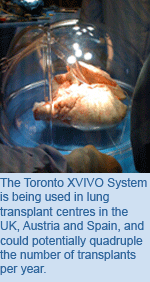 A TGRI research team has shown in a clinical trial, for the first time, that the Toronto XVIVO System can safely and effectively treat, re-assess and improve the function of high-risk donor lungs so that they can be successfully transplanted into patients. The use of this technique could significantly expand the donor organ pool and improve outcomes after transplantation.
A TGRI research team has shown in a clinical trial, for the first time, that the Toronto XVIVO System can safely and effectively treat, re-assess and improve the function of high-risk donor lungs so that they can be successfully transplanted into patients. The use of this technique could significantly expand the donor organ pool and improve outcomes after transplantation. A detailed study from TGRI, led by Dr.
A detailed study from TGRI, led by Dr. 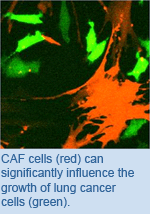 When cancer cells develop the ability to spread, other non-cancerous cells surrounding the tumour also undergo changes and develop into cells called cancer-associated fibroblast (CAF) cells. In a recent study by a group of Ontario Cancer Institute researchers, led by Dr.
When cancer cells develop the ability to spread, other non-cancerous cells surrounding the tumour also undergo changes and develop into cells called cancer-associated fibroblast (CAF) cells. In a recent study by a group of Ontario Cancer Institute researchers, led by Dr. 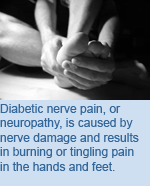 The American Academy of Neurology has issued new evidence-based guidelines for the treatment of painful diabetic neuropathy, in a publication led by TGRI’s Dr.
The American Academy of Neurology has issued new evidence-based guidelines for the treatment of painful diabetic neuropathy, in a publication led by TGRI’s Dr. 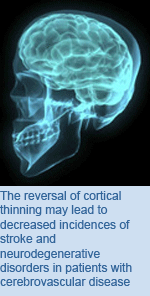 Researchers at TWRI, led by Dr.
Researchers at TWRI, led by Dr. 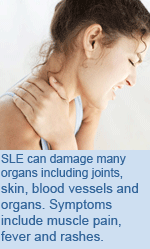 Systemic lupus erythematosus (SLE) is a chronic systemic autoimmune disorder in which the immune system attacks the body’s own cells and tissue, resulting in inflammation and tissue damage. SLE is a very complex disease in both humans and inbred mouse strains that spontaneously develop lupus-like autoimmunity. These lupus-prone mice strains are critical tools that researchers use to study how genes associated with SLE (also called susceptibility loci) alter the immune system’s functioning and interact with each other to develop this disease. Exciting new findings from TWRI’s Dr.
Systemic lupus erythematosus (SLE) is a chronic systemic autoimmune disorder in which the immune system attacks the body’s own cells and tissue, resulting in inflammation and tissue damage. SLE is a very complex disease in both humans and inbred mouse strains that spontaneously develop lupus-like autoimmunity. These lupus-prone mice strains are critical tools that researchers use to study how genes associated with SLE (also called susceptibility loci) alter the immune system’s functioning and interact with each other to develop this disease. Exciting new findings from TWRI’s Dr.